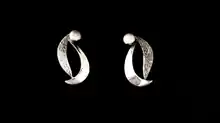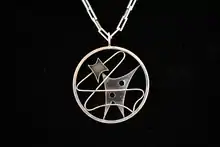Merle Boyer
Merle Newport Boyer (9 May 1920 – 29 Aug 2009) was an American modernist studio art jeweler and sculptor, as well as inventor, machinist, teacher and mentor.
Life

Boyer was born in Portland, Oregon and studied at Bradley Polytechnic Institute in Peoria, Illinois, where he took courses in horology, engraving and jewelry design[1] before moving to territorial Honolulu in 1940.[2] There he began working for C. G. Benny as an engraver and jeweler, and quickly established himself in Honolulu's burgeoning art scene. Studying at the Honolulu Academy of Arts School, he presented his work in Academy-sponsored shows, exhibitions and demonstrations throughout the war years.[1] Boyer opened his first studio on Fort St. in downtown Honolulu in 1952.[2] He was an active member of Hawai`i's craft and art community, teaching courses in jewelry at the Honolulu Academy of Arts School[1] and supporting fellow craftspeople through his role in the Hawaii Craft Association, where he served as president and vice-president.[2]
Boyer Jewelers opened on Ke`eaumoku St. in 1956. Here he continued to produce hand-wrought pieces while developing original designs for the growing tourist market in Hawai`i. He created a series of charms replicating classic Hawaiian artifacts from the Bishop Museum and used his engraving skills to produce a line of Hawaiian heirloom jewelry. He created lines for both men and women working primarily in silver accented with black coral, baroque pearls, and local woods. Individual pieces in gold and other metals using precious and semi precious stones met the tastes of individual clients.[1]
As a small business owner he developed a collaborative business model, selling in a variety of Honolulu venues, and supporting the work of apprentices and those he mentored. He continued to teach his popular jewelry making classes at the Honolulu Academy of Arts until the early 1960s.[1]

In the late ‘70s Boyer moved his business to a one-man operation, working from Young St. Although he ostensibly retired in 1984, Boyer continued to create works for friends, family and loyal clients until 2008. Among his most appreciated works was a classic design of the Hawaiian heirloom bracelet, created in gold and enamel and patterned after the bracelets Queen Kapi`olani brought back from her travels of England, as gifts for her ladies in waiting.
In the 1990s Boyer returned to his original love of sculpture. Spending several months a year traveling throughout the US and in Canada, he created works on two scales. Enchanted by the craftsmanship and design of Japanese netsuke, he carved dozens of small wearable art pieces in ivory and wood. An equal number of larger scale works in stone reflected his interest in abstract shapes and complex curves, as well as a lifelong interest with animal forms.
Style
As both an artist and a designer-craftsman, Boyer is solidly situated within the themes and approaches of the modernist studio jewelry movement.
Although he worked primarily in silver with baroque pearl, ebony, native Hawaiian woods and coral,[1] his early creations display a wide range of techniques, metals and materials. He explored inventive techniques in free-form construction as well as production work. Displaying artistry and experimentation he would create pieces out of found materials (polished rock, ceramic pieces, and shells) as well as at-hand materials. An early example can be found in the collection at the Honolulu Museum of Art. This 1944 brooch, a simple circular form, was crafted from airplane plastic, brass and copper. Later he invented techniques and tools for working with lost wax casting, metals and other materials. The sculptural shapes of his work illustrate movement and shape, light and space. Whimsical themes and kinetic movement also find their place in pieces designed for wear-ability and function.
Producing affordable jewelry as wearable art, as well as that of viewing jewelry making as a fine art in its own right, can be seen in his lines of jewelry for both men and women. His men's sets display a minimalist approach and eye for functionality. Boyer produced his designs and craftsmanship that secured his inclusion among modernist studio jewelers. His pieces were shown in several exhibitions highlighting the work of modernist studio jewelry artists during the 1950s,[2] to include the American Jewelry and Related Objects in Huntington, West Virginia.[5][6][7] and its subsequent traveling exhibition;[8] the National Decorating Arts-Ceramics Exhibition in Wichita (the Wichita National); Fiber-Clay-Metal at the St. Paul Gallery and School of Art, St. Paul, MN; the Walker exhibition on paper, presented through Design Quarterly;[3][9] and the Contemporary Craftsmen of the Far West at the Museum of Contemporary Crafts, NY in 1961, and its subsequent traveling show the following year.

Exhibitions
1943: Modern Jewelry and Metal Objects, Honolulu Academy of Arts.
1943: Oct 19-Nov 14: Juried Craft Exhibit, Honolulu Academy of Arts
1949: Juried Art Show; Honolulu Academy of Arts, Best sculpture, “Bird.”
1950: “Artists of Hawaii”, juried art show; Honolulu Academy of Arts, Honorable Mention - sculpture, “Mother and Child.”
1952: “Art in America Today”, Honolulu Academy of Art.
1953: “The Craftsmen Fair,” Honolulu Craftsmen Association.
1954: 9th National Decorating Arts-Ceramics Exhibition, Wichita Art Association, Wichita, KS.
1955: Walker Arts Center “Exhibition on Paper”. Design Quarterly 33 p. 17.
1955: American Jewelry and Related Objects, Huntington Galleries, Huntington W. VA.
1955: Fiber-Clay-Metal, St. Paul Gallery and School of Art, St. Paul, Minn
1955, 1956, 1957: One Man Show; Library of Hawaii, Honolulu.
1956-57: 2nd Exhibition of American Jewelry and Related Objects, traveling exhibition.
1961: Contemporary Craftsmen of the Far West; Museum of Contemporary Crafts, NY.
1962: Contemporary Craftsmen of the Far West, traveling exhibition:
Rochester Memorial Gallery, New York
Cincinnati Art Institute
Des Moines Art Center, Iowa
Museum of History and Industry, Seattle, Washington
1973: Daisy Gallery, Honolulu.
2005: Jewelry of Hawaii: Art and Artifice in Paradise, Honolulu Academy of Arts.
References
- Dennis, V., (1959 June 27). Along the miracle mile. Honolulu Star-Bulletin. p. 2-3.
- Chun, E., (1955 Dec 25). Work of local jeweler exhibited on mainland. The Honolulu Advertiser, A11.
- "84 Contemporary Jewelers." Design Quarterly, no. 33, 1955, pp. 14-30. JSTOR, www.jstor.org/stable/4047223.
- Schon, Marbeth (2008). Form and Function: American Modernist Jewelry, 1940-1970. Atglen, PA: Schiffer.
- (1955 Aug. 20). “Isle craftsman’s jewelry shown,” Honolulu Star-Bulletin.
- Brennen, H. (1955). American jewelry 1955: A juror’s report on a national competition. Craft Horizons, 15/3, pp. 10-13.
- Enslow, C. B., (1955 Feb 4). Jewelry–An Adornment Loved by Women. The Huntington Advertiser, p. 10.
- "American Jewelry and Related Objects: The Second National Exhibition". American Craft Council. 1957. Retrieved 2019-12-21.
- Schon, Marbeth (2004). Modernist Jewelry 1930-1960: The Wearable Art Movement. Atglen, PA: Schiffer.
Additional Resources
- Bell, Jeannenne. (2008) Answers to Questions about Old Jewelry: 1840-1950, 7th ed. Iola, WI: Krause Publications.
- King, J., (1960, Sept 15). Mauka to makai: Hawaiian Reporter.
- (1969). Directions in Design – Metals. Dave Gallagher, producer-director. Honolulu, HI: KHET.
